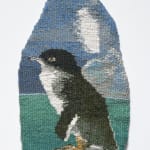Suzanne Knight Australian, b. 1964
International language of distress I (fairy penguin), 2023
Tapestry weaving (wool, bamboo, cotton), metal, wood
30cm H. x 15cm W. variable
Copyright The Artist
Further images
Seabirds exist between the open ocean and the shoreline. Some are migratory - chasing the summer across hemispheres and returning to known breeding grounds. Seabirds exist without borders or citizenship....
Seabirds exist between the open ocean and the shoreline. Some are migratory - chasing the summer across hemispheres and returning to known breeding grounds. Seabirds exist without borders or citizenship. They are truly global.
However, during my own generation these wild birds have become contained and dominated by the migration of plastic. Plastic that has become wild- free-floating around our oceans and washing up on our shorelines, without citizenship and ignoring maritime borders.
Fisheries, climate change and plastic are the greatest threats to seabirds and by 2050 there could be more plastic waste in the ocean than fish (by weight) . Plastic can be mistaken by seabirds as a tasty feed, where 90% of seabirds have eaten plastic , ingesting heavy metals, feeding plastic to hungry chicks, transporting plastic in bird droppings, creating digestive tract blockages or drowning the creatures that become entangled in it.
In considering this work I was reminded of historic explorers and the heroic notion of setting out into an unexplored world- considered so monumental that replicas of these ships were presented in bottles as reminders of epic journeys across oceans. Memorabilia of both the magnificence of the vessel and the maritime voyage itself.
Do we want our birds to become museum pieces. Specimens in a bottle like historic replicas? Will our seabirds also end up as reproductions on display, unable to complete their epic sea journeys because they became imprisoned by plastic and perished at sea? Will these beautiful birds become extinct?
The global transit of plastic is enormous and crosses many cultures, and in this work I have utilised the international language of maritime signal flags to communicate across borders, spreading the message of distress and an SOS from the wildlife that relies on the ocean.
There’s a part of ourselves in every piece of plastic floating in the ocean. We must stop using single-use plastics and actively seek alternatives.
However, during my own generation these wild birds have become contained and dominated by the migration of plastic. Plastic that has become wild- free-floating around our oceans and washing up on our shorelines, without citizenship and ignoring maritime borders.
Fisheries, climate change and plastic are the greatest threats to seabirds and by 2050 there could be more plastic waste in the ocean than fish (by weight) . Plastic can be mistaken by seabirds as a tasty feed, where 90% of seabirds have eaten plastic , ingesting heavy metals, feeding plastic to hungry chicks, transporting plastic in bird droppings, creating digestive tract blockages or drowning the creatures that become entangled in it.
In considering this work I was reminded of historic explorers and the heroic notion of setting out into an unexplored world- considered so monumental that replicas of these ships were presented in bottles as reminders of epic journeys across oceans. Memorabilia of both the magnificence of the vessel and the maritime voyage itself.
Do we want our birds to become museum pieces. Specimens in a bottle like historic replicas? Will our seabirds also end up as reproductions on display, unable to complete their epic sea journeys because they became imprisoned by plastic and perished at sea? Will these beautiful birds become extinct?
The global transit of plastic is enormous and crosses many cultures, and in this work I have utilised the international language of maritime signal flags to communicate across borders, spreading the message of distress and an SOS from the wildlife that relies on the ocean.
There’s a part of ourselves in every piece of plastic floating in the ocean. We must stop using single-use plastics and actively seek alternatives.











